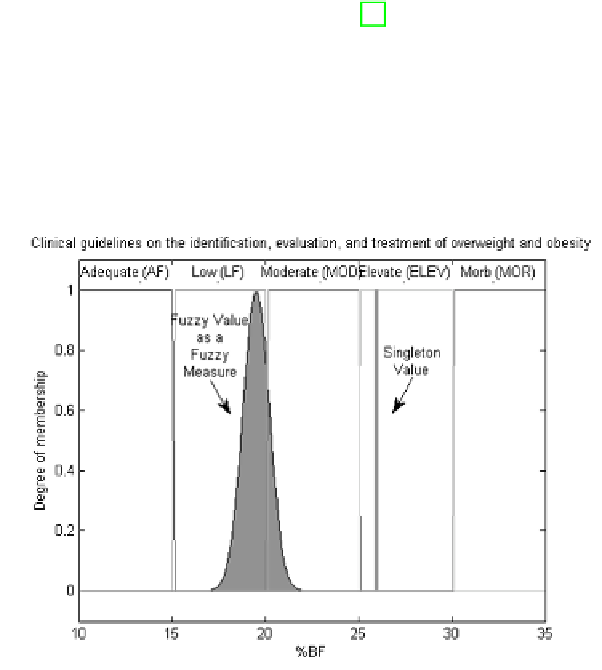Information Technology Reference
In-Depth Information
extended and validated by experimental data in [15]. In order to exemplify the dif-
ference between fuzziness in measure and fuzzy measure, consider the classic and
fuzzy %BF obesity classifications. Take into account that according to the mecha-
nism or methodology employed to measure the %BF, a fuzzy value (fuzzy set) or a
singleton value is achieved, respectively, representing either a subjective (imperfect)
or a certain and precise (perfect) evidence during diagnostic or analysis, as depicted
in Fig. 16.3 and 16.4.
Fig. 16.3
Example of fuzzy measure to a
possible
crisp set
Observe that when dealing with crisp classes and there is a perfect evidence,
a full membership value achieves only one class,
M
Elev
, such that
M
Elev
(
1
(right measure in Fig. 16.3). In so doing, there is no fuzziness associated to their
boundaries. The upper index,
S
, refers to the singleton measure. Otherwise, when
dealing with subjective (or in doubt, inconclusive) classes, here associated to fuzzy
sets, there may be either a full membership, when the singleton value coincides to
the core of the membership function, or a partial membership, when such a mea-
sure achieves unsharp borders of the fuzzy set yielding distinct degrees of activation
(right measure in Fig. 16.4). In this example, the measure of fuzziness is obtained
when a measure,
x
, generates two degrees of activation,
μ
x
)=
S
S
,re-
spectively, by achieving the fuzzy moderate obesity set,
M
Mod
, and the fuzzy elevate
obesity set,
M
Elev
, such that 0
μ
M
Mod
(
x
)
and
μ
M
Elev
(
x
)
S
S
1. On the other hand, when
the measure assumes fuzzy evidence, there is not a full membership value when
dealing with crisp classes, yielding an inconclusive classification (left measure in
Fig. 16.3). The example of fuzzy measure reflects the ambiguity, subjectivity as-
sociated to two disjoint, well-defined sets. The classic low obesity set,
M
LF
,and
<
μ
M
Mod
(
x
)
<
μ
M
Elev
(
x
)
<




